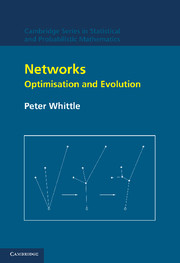Book contents
- Frontmatter
- Contents
- Acknowledgements
- Conventions on notation
- Tour d'Horizon
- Part I Distributional networks
- 1 Simple flows
- 2 Continuum formulations
- 3 Multi-commodity and destination-specific flows
- 4 Variable loading
- 5 Concave costs and hierarchical structure
- 6 Road networks
- 7 Structural optimisation: Michell structures
- 8 Computational experience of evolutionary algorithms
- 9 Structure design for variable load
- Part II Artificial neural networks
- Part III Processing networks
- Part IV Communication networks
- Appendix 1 Spatial integrals for the telephone problem
- Appendix 2 Bandit and tax processes
- Appendix 3 Random graphs and polymer models
- References
- Index
6 - Road networks
Published online by Cambridge University Press: 23 November 2009
- Frontmatter
- Contents
- Acknowledgements
- Conventions on notation
- Tour d'Horizon
- Part I Distributional networks
- 1 Simple flows
- 2 Continuum formulations
- 3 Multi-commodity and destination-specific flows
- 4 Variable loading
- 5 Concave costs and hierarchical structure
- 6 Road networks
- 7 Structural optimisation: Michell structures
- 8 Computational experience of evolutionary algorithms
- 9 Structure design for variable load
- Part II Artificial neural networks
- Part III Processing networks
- Part IV Communication networks
- Appendix 1 Spatial integrals for the telephone problem
- Appendix 2 Bandit and tax processes
- Appendix 3 Random graphs and polymer models
- References
- Index
Summary
The setting
We are daily and directly convinced of the importance of traffic networks, and more particularly of road networks, and of the desirability that the factors that ensure their smooth running should be well understood. There is a vast literature on the subject, and a substantial body of theory, which must indeed take account of new factors.
The road network is a graph, whose streets constitute the arcs and whose junctions the nodes. However, traffic does not consist of just a single ‘commodity’ to be shunted around the network, but breaks up into classes labelled by their destination, and possibly by other characters as well. For simplicity, we shall suppose that destinations coincide with exit nodes.
This seems then just a particular case of the destination-specific distribution net of Chapter 2. However, we saw there that a naive optimisation led to a totally unrealistic solution, in which every origin–destination pair for which there was demand was connected by a direct route, of rating matched to this demand. Such a solution ignores a multitude of issues, arguable only in the order in which one should list them. From the aesthetic or environmental point of view, one could never allow the countryside to suffer this death of a thousand cuts. From the utilitarian point of view, land, and substantial blocks of it, is needed for other purposes (e.g. homes, offices, shopping, industry, agriculture, leisure activities, plus access to some sites and total protection of others), and its usage must be planned.
- Type
- Chapter
- Information
- NetworksOptimisation and Evolution, pp. 85 - 94Publisher: Cambridge University PressPrint publication year: 2007

